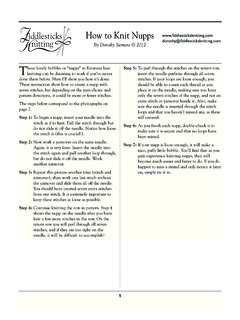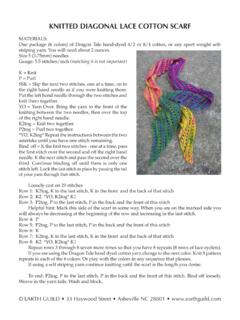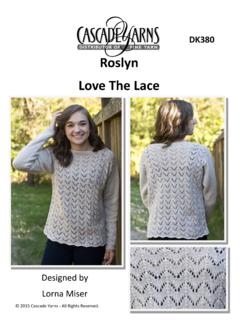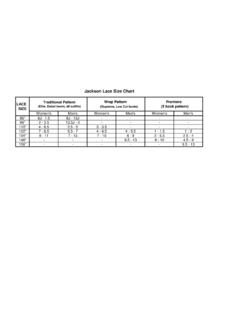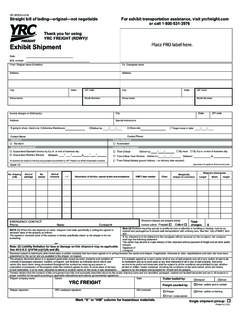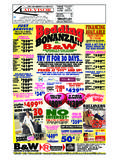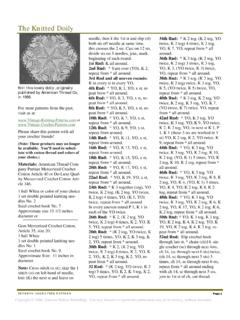Transcription of Lace Knitting Charts
1 Understanding Charts in Lace KnittingA chart is a visual representation of the knitted piecein symbol form. In written row-by-row instructionsthere is no visual similarity at all to the actual knittedfabric. This is one of the main reasons why, once a person becomes familiar with Charts , they usually prefer them. Each square of the chart represents one stitch of each square represents one stitch of Knitting , thesymbols inside each square indicate what that particularstitch should be. There is usually an attempt to havethe symbol mimic in graphic form the look or structureof the actual stitch. The chart should be accompaniedby a table or legend which explains the symbols foundin the chart . Symbols are not standardized, and whilesome are used frequently (a circle for a yarnover), others may be different depending on who has designedthe chart .
2 Checking the chart symbols table is importantto make sure you are working the correct stitch according to that particular speaking, the chart symbols should line up in the same way as your Knitting . If you compare achart to your finished Knitting , you should see a visual similarity. This makes it much easier to track where youare in the Knitting , as opposed to written out, row-by-row instructions, which can become overwhelminglydense in a complicated pattern. Lace chart SymbolsSome typical lace chart symbols are profiled in thetable at right. These are just a few of the symbols youcould encounter as you work a chart for lace, and whenyou read the descriptions you can see that there arealready potential problems if you don t familiarize yourself with the designer s intentions first.
3 There have been various attempts to standardize thesymbology of Knitting Charts , but individual designersin North America like the freedom of adapting orchanging symbols to suit their taste. In Japan, knittingand crocheting symbols have been standardized by theJapanese Industrial Standard, and all published material adheres to this standard. Patterns are createdas schematics and Charts , with very little writteninstruction, so if you understand the language of thecharts you don t need to understand Japanese in orderto knit from them. Estonian chart symbols are differentagain, using black squares representing knit stitches. Now on to the Knitting ChartsBy Dorothy Siemens blank square often means to knit the stitch. A vertical line can also mean knit. A small dot often means to purl the horizontal line can also mean purl.
4 A circle usually means yarnover, yarn over needle, or yarn forward. A forward slash usually means to knit two stitches together (or in short form, k2tog), which creates aone-stitch decrease that leans to the symbol can also mean k2tog, (two lines atthe bottom converge to create one right-leaningslash at the top). Some designers (and I am one ofthem) use this symbol to mean k3tog, a two-stitchdecrease. That is why it is important to check thechart symbols backward slash usually means to slip 1 stitch knitwise, knit 1 stitch, then pass the slipped stitchover the knit stitch (skp). Some people prefer towork ssk, which means to slip 1 stitch knitwise,slip the next stitch knitwise, then insert the leftneedle into the two stitches from left to right andknit the two stitches together.
5 Either method produces a one-stitch, left-leaning in the k2tog example above, this symbol canalso mean skp or ssk. However, some designers usethis symbol to mean slip 1 stitch knitwise, k2tog, pass the slipped stitch over the knitted stitches, or atwo-stitch decrease rather than a one-stitch decrease. oSimple ChartCharts are read by starting at the bottom right cornerand reading the squares of the first row across to theleft. Therefore, the first chart row usually starts with anumber 1 at the bottom right corner. This would correspond with the first row of Knitting , which alsostarts at the right side and works across to the left. Inthe very simple chart below, we can see that there isone row of seven stitches. Referring to the chart symbols table, we can see that the first stitch should bea knit stitch, followed by a knit two stitches together decrease, a yarnover, a knit stitch, a yarnover, then a slip one stitch knitwise, knit one stitch, pass slippedstitch over knit stitch decrease, ending with a this was written out, it would probably look somethinglike this.
6 Note the abbreviations for the different typesof stitches:Row 1:k1; k2tog; yo; k1; yo; skp; is much easier with the chart to instantly grasp thepattern, since it resembles the actual RowsMost Charts are more complex than the one above anduse multiple rows. In the chart at right, there are fouractual rows shown, butthey are numbered 1 through 7. Only oddnumbers are shown, andthe even numbers areomitted. The odd-numbered rows representthe right side of the fabric. The even-numbered rows, whichare not shown, representthe wrong side of thefabric. A chart such as this should have an accompany-ing instruction which indicates how to work the chartand how to work stitches on the wrong side. In thiscase, all wrong side rows should be purled. Therefore, read the chart and knit your work as in the chart symbols table that the descriptions ofstitches are further abbreviated:Row 1:Starting at the lower right corner square andreading across the first row to the end, knit 7 2:This is not shown on the chart , but theinstructions indicate that you should purl 3:Starting at the right side, read the second tierof squares across to the left, following the chartsymbols as you go, therefore: k1; k2tog; yo; k1;yo; skp; 4:Not shown, purl all 5:Read the third tier of squares, therefore: k2;skp; yo; 6:Not shown, purl all 7:Knit all thateven though thechart seems to onlygo to Row 7, youmust finish it bypurling Row 8.
7 Theknitted fabric lookslike the photo notice how the three holes correspondto the three yo symbols on the chart , something that isnot obvious from the written row-by-row Side and Wrong Side ChartsCharts can also show both right side and wrong siderows. This usually occurs when the wrong side row haspatterning that needs to be shown. In this case, right-side rows will be indicated by odd numbers on the rightside of the chart , and wrong-side rows will be indicatedby even numbers on the left side of the chart . Thechart rows for odd numbers are read from right to left,as previously discussed, but the chart rows for evennumbers are read from left to right. If you are unfamiliar2ooKnit (k)Knit 2 stitches together (k2tog)Yarn over needle (yo)Slip 1 stitch knitwise, knit 1 stitch, pass slippedstitch over knit stitch (skp)o 1ooo7531 Knit (k)K 2 together (k2tog)Yarnover (yo)Sl1, k1, psso (skp)owith it, this can be confusing at first, because you willbe Knitting from right to left regardless of whether youare working on the right or wrong side.
8 Again, it isimportant to read the chart symbols table to understandhow to read the symbols on the right or wrong side. Astandard convention is to show what the stitch lookslike from the right side of the fabric. So on the rightside, a knit stitch is shown as a blank square. On thewrong side it is also shown as a blank square, butshould be purled, so as to be a knit stitch when viewedfrom the right side of the fabric. Arrows show directionof chart reading. First row (RS) is read across the chartfrom right to left. Second row (WS) is read across thechart from left to right and so , read and work the chart as follows, notingthe following abbreviations:k = knitk2tog = knit 2 togetherp = purlRS = right sideskp = slip 1, knit 1, pass slipped st overst = stitchWS = wrong sideyo = yarn over needleRow 1 (RS):k3; k2tog; yo; 2 (WS):k2; p5; k2.
9 Note that even though thesymbol at the beginning of the rowappears to be a purl symbol (small dot),we are on the WS and it should be knitsince it will appear to be purl on the same occurs for the square showinga knit st it should be purled on theWS to give a knit st on the 3:k2; k2tog; yo; k1; yo; skp; 4:k2; p5; 5:k3; skp; yo; 6:k2; p5; chart creates a 2-stitch garter edge at either end,with the lace motif in stocking Stitch ChartsAgain, it is important to review what the designerintends, as Charts can also be set up in a simplified way to avoid cluttering up the graph with too muchinformation, such as in the example below, where thedesign is in garter top chart shows purl symbols on even-numberedrows to indicate that the knitted fabric is in garterstitch. The bottom chart shows the same information withoutthe busyness of the rows of purl dots.
10 Note that thechart symbols table describes how to work the stitchesfor garter stitch on both RS and WS , while this does not occur often, a chart couldshow all symbols to be worked as they appear, regardlessof RS or WS. This chart won t give the appearance ofthe knitted fabric from the front, but can make it easierto work complex designs without needing to translatesymbols for RS and WS. Again, the designer s intentions should be made clear in the instructions or chart symbols ooook on RS, p on WSp on RS, k on WSk2togyoskpo 531642 ooook on RS, p on WSp on RS, k on WSk2togyoskpo 531642ooook on both RS and WSk2togyoskpoCharts in the RoundWhen working in the round, all rows will be read fromright to left and numbered on the right-hand side ofthe chart .
